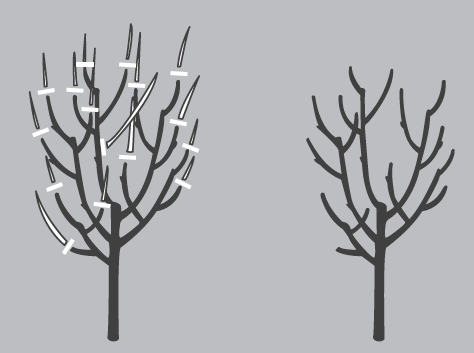[ad_1]
Whether you’re an experienced tree pruner or you’re just beginning your career, there are several different aspects of tree pruning to consider. These include pruning error, thinning cuts, and structural (subordination) cuts.
Reducing error pruning
During the process of pruning, it is important to not reduce the predictive power of the model. It is also important to make sure that the pruning does not reduce the overall accuracy of the model.
Pruning procedures involve selecting the right sub-trees to prune and the best method to prune them. The process also involves the removal of sections of the tree that have little or no relevance to the classification task. This is done to reduce the size of the decision tree and improve the predictive accuracy of the final model.
The process of pruning can be broken into two steps: pre-pruning and post-pruning. Pre-pruning is performed when the number of instances of a node is less than a percentage of the total training set. This is used to avoid complete induction of the training set.
The process of pruning involves removing a sub-tree with a particular node. This process is often used to improve the classification accuracy of unseen objects. It is also used to eliminate noise.
Structural (subordination) cuts
During tree pruning, there are two types of cuts: thinning and structural (subordination) cuts. Thinning cuts remove the branches at the point of origin. This will open the canopy and increase light penetration.
Structural cuts are used to increase the structural integrity of the tree. They slow the growth of competing leaders and shorten their length. This will promote healthy growth and reduce maintenance costs in the future.
Structural pruning is a technique that should be applied to most tree species. The most important goal of structural pruning is to establish a dominant leader. The dominant leader must be in the center of the crown and free of defects.
Structural pruning should be done at least once every two years. The best time is during the dormant season. It also works best on young trees. It will encourage more growth in the dominant leader and decrease the number of competing leaders.
In addition to shortening the length of competing leaders, structural pruning also decreases the conditions within the tree that could be dangerous. This includes pruning deadwood, limbs growing toward obstructions, and weak branch unions. It also improves the overall appearance of the tree.
Thinning cuts
During tree pruning, a thinning cut is a type of cut that removes a portion of a limb. This is done in order to maintain the tree’s shape and form. The cut also helps to improve light penetration and air circulation.
The three basic cuts that are used in tree pruning are thinning cuts, heading cuts, and releadering cuts. Each of these cuts is used for a different purpose. For thinning, the cut is made just above the parent wood. The result is a thinner and shorter limb.
Heading cuts are the opposite of thinning cuts. The cut is made to a weak node. This is usually the point of origin of the branch. The cut stimulates growth in the top buds, and stimulates new growth in the branches nearest the cut. These cuts are best used on branches that are less than a third of the diameter of the trunk.
Releadering is a cut that is made to a lateral branch on the right side of the tree. The lateral branch is removed just outside the branch collar. This helps to thin the co-dominant leaders.
Recovering from a storm
During storms, wind, hail and heavy snow damage may occur to your trees. These events can be damaging to the health of your trees, and it may take some time to get them back to their original condition. However, there are things you can do to help them recover.
The first step is to remove dead branches. These branches can fall and harm someone. If they are near power lines, they can also get tangled and pose a threat. The best way to avoid these types of accidents is to have them removed by a qualified tree service contractor.
The second step is to prune damaged branches. You can prune the damaged limbs at the trunk or at the point where they join larger branches. Doing this will minimize the exposed area of woody tissue and minimize the risk of decay agents entering the wound.
When pruning, you should do it carefully and cleanly. If you are unsure of how to do it, consult a qualified arborist.
[ad_2]


I like this website it’s a master piece!
Glad I detected this ohttps://69v.topn google.Raise your business